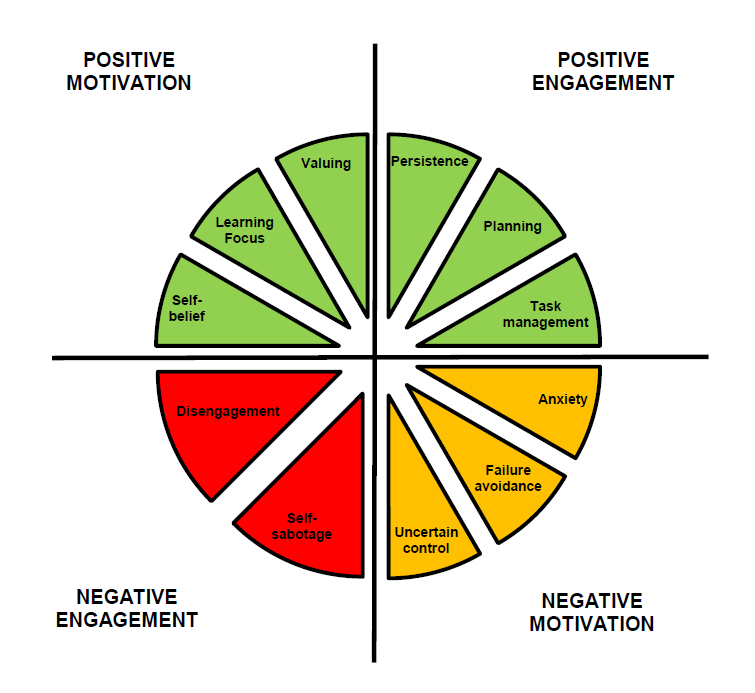How much does student motivation and engagement change over the course of a day, a week, and a month at school? How much does motivation and engagement vary from student to student?
We sought answers to these questions in a recent study published in the journal, Learning and Individual Differences.
Three times a day, five days a week, for four weeks, we tracked 20 high school students.
Students were asked to rate themselves on the motivation and engagement factors in the Motivation and Engagement Wheel (see figure below) using their mobile devices. For each factor, they responded to questions on a one (Strongly Disagree) to seven (Strongly Agree) scale, in the morning, the middle of the day, and again in the afternoon.
What is motivation and engagement?
Motivation is students' energy and drive to learn, work effectively, and achieve. Engagement is typically seen as the behaviours that follow from this energy and drive.
The motivation and engagement factors in our study were those in the Motivation and Engagement Wheel – assessed using the short version of the Motivation and Engagement Scale (Martin, 2014).
The wheel is separated into:
- Positive motivation (self-belief, learning focus, valuing);
- Positive engagement (planning behaviour, task management, persistence);
- Negative motivation (anxiety, failure avoidance, uncertain control);
- Negative engagement (self-sabotage, disengagement; coded red as these factors are substantially more problematic than negative motivation factors).

The Motivation and Engagement Wheel (reproduced with permission from Martin, A.J. and Lifelong Achievement Group; download from www.lifelongachievement.com)
Why does change in motivation and engagement matter?
Whether a student's motivation and engagement changes through the course of a day, week, or month at school has significant implications for teachers.
If these factors are relatively stable across this period, this suggests it is more a trait of the student and not something that varies in response to different subjects, teachers, activities, and tasks. That is, it might suggest there is a fixed motivation and engagement ‘set-point' for each student that will not change much from subject to subject, class to class, or task to task.
However, if motivation and engagement is somewhat variable through the day, then this tells us it is very important to identify factors or events that are causing this shift.
A similar question concerns variability from student to student. If there are relatively few differences between students, then motivation and engagement would seem to be something that is stable and not something that would benefit from instructional attention. However, if there are significant variations, then clearly there are some students who may need additional support.
Change in motivation and engagement matters because these factors are related to learning, achievement, and enjoyment of school. Thus, the extent to which we can boost motivation and engagement has direct implications for the extent to which we can boost learning, achievement, and enjoyment.
What did we find?
From our research, we found two major patterns among students.
First, there was far more variation in motivation and engagement throughout the school day than between school days and weeks. Initially we thought this may be due to the time of day; for example, rising from the start of the day to the middle of the day, then declining in the afternoon. But, this was not the case.
Instead, it depended on what the students were doing (for example, the class they were in, the teacher they had, the task they were performing.).
Our second major finding was that there was substantial variation in motivation and engagement between students. In fact, drawing on previous research (Martin et al., 2011), there is far more variation in motivation and engagement from student to student than there is from class to class or school to school.
What does this mean for educators?
With regards to the first major finding, if motivation and engagement varies through the day, this underscores the importance of quality instruction, assessment, activity, interaction, and student management.
The findings suggest students respond to and interact with their environment, and it is this interaction that contributes to their real-time motivation and engagement. It is thus possible for a student to leave one lesson switched on, then enter another lesson and become switched off, and vice versa. This cautions us against classifying students as 'motivated' or 'unmotivated', 'engaged' or 'disengaged'.
The changes we saw suggest that the ‘unmotivated student' has motivated moments and the ‘disengaged student' has engaged moments. These are moments that teachers can seize and capitalise on for instruction.
Likewise, the ‘motivated students' can have their unmotivated moments and the ‘engaged students' can have their disengaged moments. Teachers should be watchful of this and look to redirect these students back on track as appropriate.
Our findings also suggest teachers cannot rely on a fixed positive ‘set-point' of motivation and engagement among their students as a buffer for poor quality instruction and activity. It seems there is no such fixed ‘set-point'.
With regards to the second major finding, if motivation and engagement varies substantially from student to student, then clearly the classroom comprises substantial diversity and individual differences. This presents a challenge for educators in group settings (namely, the classroom) and once more suggests the importance of individualised and differentiated approaches to instruction where possible.
Given the substantial variation in motivation and engagement throughout the school day and between students, we conclude every moment of every day for every student matters.
References
Martin, A.J. (2014). The Motivation and Engagement Scale (14th Ed.). Sydney: Lifelong Achievement Group. Retrieved from www.lifelongachievement.com
Martin, A.J., Bobis, J., Anderson, J., Way, J., Vellar, R. (2011). Patterns of multilevel variance in psycho-educational phenomena: Exploring motivation, engagement, climate, teacher, and achievement factors. German Journal of Educational Psychology / Zeitschrift für Pädagogische Psychologie, 25, 49-61.
Martin, A.J. Papworth, B., Ginns, P., Malmberg, L-E., Collie, R., Calvo, R.A. (2015). Real-time motivation and engagement during a month at school: Every moment of every day for every student matters. Learning and Individual Differences, 38, 26-35.



